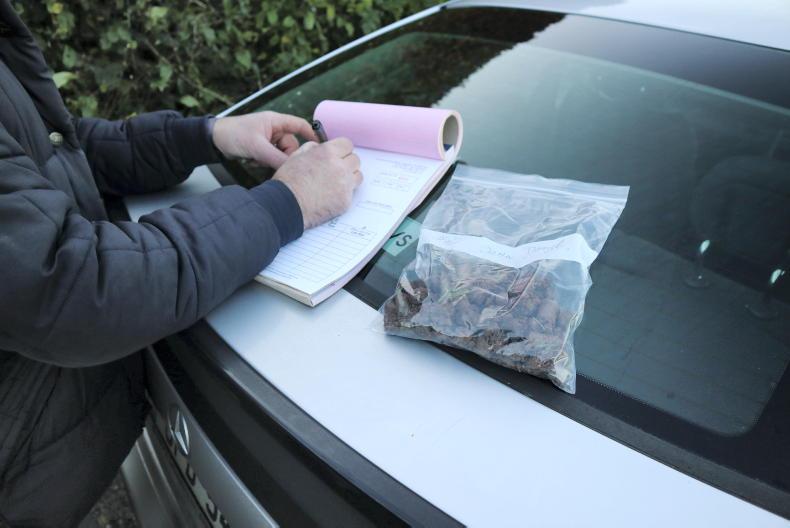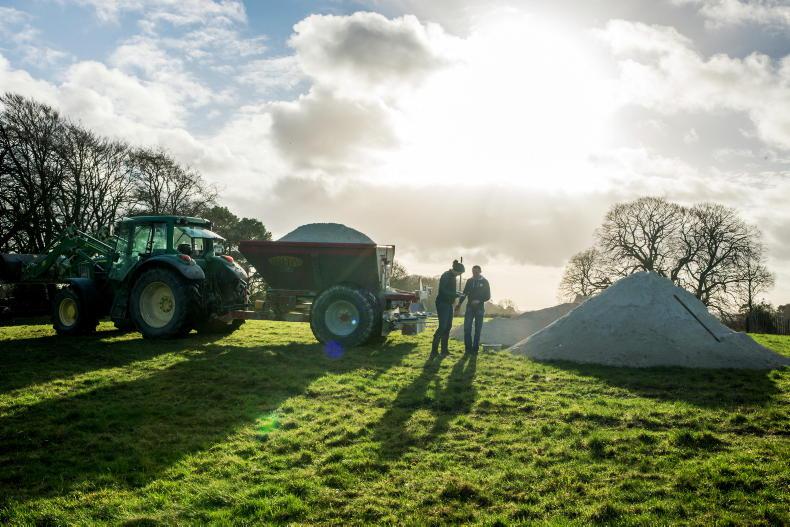Soil sampling is the key to knowing what your soil fertility status is.
Soil sampling should be done three to six months after the last phosphorous (P) and potassium (K) applications.
In most cases, the ideal time to do soil samples is in December and January.
One sample should be taken from every two to four hectares and the samples should be taken to a depth of 10cm.

The results will give a clear picture of the status of the farm and is the first step towards coming up with a nutrient management plan.
Correcting pH
Correcting soil PH should be the first priority. The target pH of the soil is 6.2 to 6.5.
Spreading lime on low-pH soils will increase the pH towards the target. Each paddock can be different and the application rates will differ as a result.

Spreading lime on low-pH soils.
A maximum of 6t lime/ha or 2.5t/acre should be spread at any one time. If the soil requires more than this, it can be topped up two years later.
Autumn is the ideal time to spread lime, as grass covers are low and it will set up the farm for the coming year.
Lime is vital for the release of nitrogen in the soil and also unlocks soil P and K.
The biggest advantage of lime and correcting the soil PH is it will increase the response to N, P and K fertilisers.

Lime application is key to improving the fertility of low-pH soils.
Knowing the soil fertility status allows you to be selective with where P and K fertiliser is being spread.
This can sometimes mean less fertiliser is required, as soils in index 3 and 4 only need maintenance levels.
Slurry applications can also be targeted on low-index soils to help build the index. Little and often is the best approach to building indices.
P applications should be targeted early in the year, as P is important for plant and root development and stimulates early grass growth. P cannot be spread during the closed period.
Care is needed when spreading high levels of K in one application, as high levels of K in grass or silage can result in grass tetany or milk fever, as magnesium and calcium are tied up.
Like P, little and often is the best approach, but as there is no closed period for K application, autumn is a good time to spread K to help build the soil index.
Soil sampling is the key to knowing what your soil fertility status is.
Soil sampling should be done three to six months after the last phosphorous (P) and potassium (K) applications.
In most cases, the ideal time to do soil samples is in December and January.
One sample should be taken from every two to four hectares and the samples should be taken to a depth of 10cm.

The results will give a clear picture of the status of the farm and is the first step towards coming up with a nutrient management plan.
Correcting pH
Correcting soil PH should be the first priority. The target pH of the soil is 6.2 to 6.5.
Spreading lime on low-pH soils will increase the pH towards the target. Each paddock can be different and the application rates will differ as a result.

Spreading lime on low-pH soils.
A maximum of 6t lime/ha or 2.5t/acre should be spread at any one time. If the soil requires more than this, it can be topped up two years later.
Autumn is the ideal time to spread lime, as grass covers are low and it will set up the farm for the coming year.
Lime is vital for the release of nitrogen in the soil and also unlocks soil P and K.
The biggest advantage of lime and correcting the soil PH is it will increase the response to N, P and K fertilisers.

Lime application is key to improving the fertility of low-pH soils.
Knowing the soil fertility status allows you to be selective with where P and K fertiliser is being spread.
This can sometimes mean less fertiliser is required, as soils in index 3 and 4 only need maintenance levels.
Slurry applications can also be targeted on low-index soils to help build the index. Little and often is the best approach to building indices.
P applications should be targeted early in the year, as P is important for plant and root development and stimulates early grass growth. P cannot be spread during the closed period.
Care is needed when spreading high levels of K in one application, as high levels of K in grass or silage can result in grass tetany or milk fever, as magnesium and calcium are tied up.
Like P, little and often is the best approach, but as there is no closed period for K application, autumn is a good time to spread K to help build the soil index.









 This is a subscriber-only article
This is a subscriber-only article










SHARING OPTIONS: